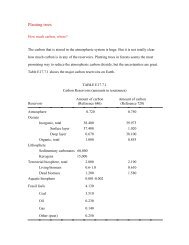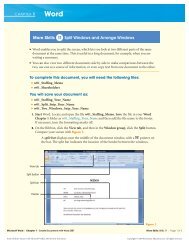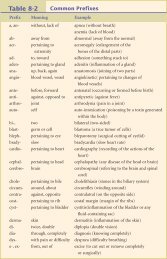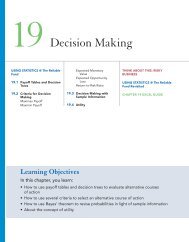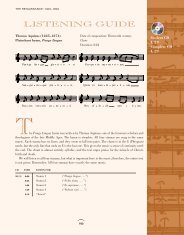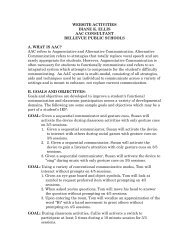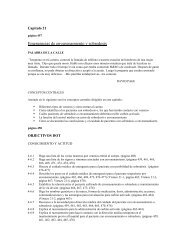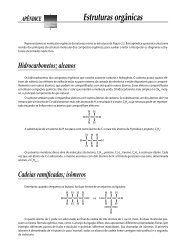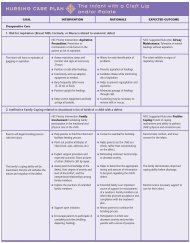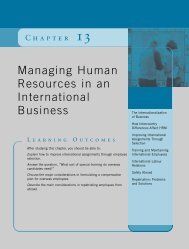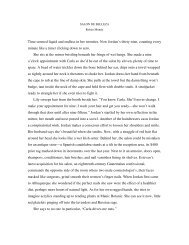chapter
chapter
chapter
Create successful ePaper yourself
Turn your PDF publications into a flip-book with our unique Google optimized e-Paper software.
the exciting concept of continents in motion held their<br />
interest. Others viewed continental drift as a solution<br />
to previously unexplainable observations.<br />
Plate Tectonics: The New Paradigm<br />
EEA R T H S C I E N C E<br />
Forces Within<br />
Plate Tectonics<br />
During the years that followed Wegener’s proposal,<br />
major strides in technology permitted mapping of the<br />
ocean floor. Moreover, extensive data on seismic activity<br />
and Earth’s magnetic field became available. By 1968,<br />
these developments led to the unfolding of a far more<br />
encompassing theory than continental drift, known as<br />
plate tectonics. The implications of plate tectonics are so<br />
far-reaching that this theory is today the framework<br />
within which to view most geologic processes.<br />
Earth’s Major Plates<br />
According to the plate tectonics model, the uppermost<br />
mantle, along with the overlying crust, behaves as a<br />
strong, rigid layer, known as the lithosphere. This outermost<br />
shell overlies a weaker region in the mantle<br />
known as the asthenosphere. Further, the lithosphere is<br />
broken into numerous segments called plates, which<br />
are in motion and are continually changing in shape<br />
and size. As shown in Figure 7.8, seven major lithospheric<br />
plates are recognized. They are the North American,<br />
South American, Pacific, African, Eurasian,<br />
Australian-Indian, and Antarctic plates. The largest is<br />
the Pacific plate, which is located mostly within the Pacific<br />
Ocean. Notice from Figure 7.8 that several of the<br />
large plates include an entire continent plus a large area<br />
of seafloor (for example, the South American plate). This<br />
is a major departure from Wegener’s continental drift<br />
hypothesis, which proposed that the continents moved<br />
through the ocean floor, not with it. Note also that none<br />
of the plates are defined entirely by the margins of a<br />
continent.<br />
Intermediate-sized plates include the Caribbean,<br />
Nazca, Philippine, Arabian, Cocos, and Scotia plates. In<br />
addition, there are over a dozen smaller plates that have<br />
been identified but are not shown in Figure 7.8.<br />
The lithospheric plates move relative to each other<br />
at a very slow but continuous rate that averages about<br />
5 centimeters (2 inches) per year. This movement is ultimately<br />
driven by the unequal distribution of heat<br />
within Earth. Hot material found deep in the mantle<br />
moves slowly upward and serves as one part of our<br />
planet’s internal convection system. Concurrently,<br />
cooler, denser slabs of oceanic lithosphere descend into<br />
the mantle, setting Earth’s rigid outer shell into motion.<br />
Ultimately, the titanic, grinding movements of<br />
Earth’s lithospheric plates generate earthquakes, cre-<br />
Chapter 7 Plate Tectonics 199<br />
ate volcanoes, and deform large masses of rock into<br />
mountains.<br />
Plate Boundaries<br />
Lithospheric plates move as coherent units relative to all<br />
other plates. Although the interiors of plates may experience<br />
some deformation, all major interactions<br />
among individual plates (and therefore most deformation)<br />
occur along their boundaries. In fact, the first attempts<br />
to outline plate boundaries were made using<br />
locations of earthquakes. Later work showed that plates<br />
are bounded by three distinct types of boundaries,<br />
which are differentiated by the type of movement they<br />
exhibit. These boundaries are depicted at the bottom of<br />
Figure 7.8 and are briefly described here:<br />
1. Divergent plate boundaries (constructive margins)—where<br />
two plates move apart, resulting in<br />
upwelling of material from the mantle to create<br />
new seafloor (Figure 7.8A).<br />
2. Convergent plate boundaries (destructive margins)—where<br />
two plates move together, resulting<br />
in oceanic lithosphere being thrust beneath an<br />
overriding plate, eventually to be reabsorbed into<br />
the mantle (Figure 7.8B). Convergence can also result<br />
in the collision of two continental plates to<br />
create a mountain system.<br />
3. Transform fault boundaries (conservative margins)—where<br />
two plates grind past each other<br />
without the production or destruction of lithosphere<br />
(Figure 7.8C).<br />
Each plate is bounded by a combination of these<br />
three types of boundaries. For example, as shown in<br />
Figure 7.8, the Nazca plate has a divergent zone on the<br />
west, a convergent boundary on the east, and numerous<br />
transform faults, which offset segments of the divergent<br />
boundary. Although the total surface area of Earth does<br />
not change, individual plates may diminish or grow in<br />
area depending on the distribution of convergent and<br />
divergent boundaries. The Antarctic and African plates<br />
are almost entirely bounded by spreading centers and<br />
hence are growing larger. By contrast, the Pacific plate<br />
is being consumed into the mantle along its northern<br />
and western flanks and is therefore diminishing in size.<br />
Furthermore, new plate boundaries can be created<br />
in response to changes in the forces acting on these rigid<br />
slabs. For example, a relatively new divergent boundary<br />
is located in Africa, in a region known as the East<br />
African Rift Valleys. If spreading continues there, the<br />
African plate will split into two plates separated by a<br />
new ocean basin. At other locations, plates carrying continental<br />
crust are presently moving toward each other.<br />
Eventually, these continents may collide and be sutured<br />
together. Thus, the boundary that once separated two<br />
plates disappears as the plates become one. The result




